Mad Hedge Technology Letter
October 30, 2024
Fiat Lux
Featured Trade:
(LACK OF AI ROCKS THE KOREAN HEAVYWEIGHT)
(SAMSUNG), (SK HYNIX)

Mad Hedge Technology Letter
October 30, 2024
Fiat Lux
Featured Trade:
(LACK OF AI ROCKS THE KOREAN HEAVYWEIGHT)
(SAMSUNG), (SK HYNIX)

It’s not just about smartphones for Samsung anymore, their stalwart chip business is in full-blown crisis mode as they have been too slow to adapt to the artificial intelligence revolution.
It shows that if a company is asleep at the wheel, how quickly and how far they can fall back.
Samsung is Korea’s flagship tech company, and it is like the Titanic in a way because it is hard to turn around with the amount of employees it has.
Old habits die hard, and management simply wasn’t prepared for the giant leap forward in semiconductor chips.
Remember when their flagship smartphone, named the Galaxy, was the best phone in the world?
Oh, have times changed?
Concerns are piling up that the company is losing out to smaller rival SK Hynix in AI memory and failing to gain on Taiwan Semiconductor Manufacturing.
Overseas investors have sold about $10.7 billion worth of the South Korean company’s shares on a net basis since the end of July.
That hope has been snuffed out with the company admitting delays with its latest-generation HBM chips in early October, soon after SK Hynix said it had begun volume production. Meanwhile, US rival Micron Technology is stepping up efforts in HBM as well and has reported strong demand for its offerings.
Beyond its lag in AI memory, Samsung has struggled with a costly, yearslong effort to close the gap with TSMC in the foundry business. Like Intel— which has run into similar difficulty with plans to expand its outsourced chipmaking operations — the Korean firm is now moving to cut jobs and make other efforts to stop the bleeding.
Jay Y. Lee — a grandson of Samsung’s founder who was appointed executive chairman two years ago — was acquitted of stock manipulation charges in February after years of legal issues. Three months later, the company unexpectedly replaced its semiconductor division head with Jun Young-hyun, a memory chip veteran.
Samsung executives and engineers are now in full unison, heading towards the exits, looking for greener pastures, and that is a massive red flag.
It certainly isn’t a good optics when the best talent is looking for another job, but that is where we are at with Samsung.
In the short term, I don’t expect a quick turnaround because the management problems are real, and to get competitive in AI is a tall order.
Just look at AMD, they are about a year behind Nvidia, and Samsung isn’t even in the ballpark.
I expect a slow slide into irrelevancy and foreign shareholders dumping big swaths of Samsung stock backs this theory.
In the short term, readers shouldn’t get too fancy with picking AI stocks because there is a massive risk to the downside, considering how expensive the equity market is right now.
Samsung won’t be the last company to be swept up by the dustbin of tech firms.
In the U.S., it is clear which companies are behind and which are leading.
Microsoft is definitely one to buy the dip on.
I definitely envision at least one fiercer rally in AI stocks as we cruise past the U.S. election.
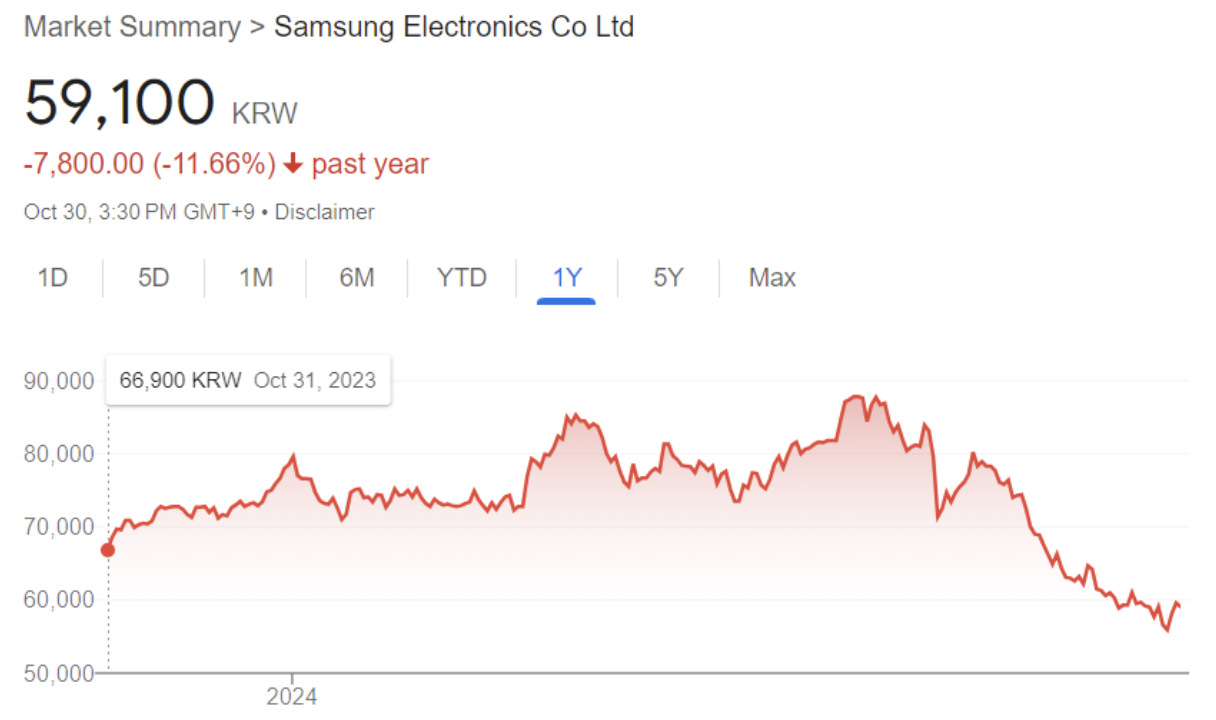
Mad Hedge Technology Letter
September 29, 2023
Fiat Lux
Featured Trade:
(WHAT TO DO ABOUT MICRON)
(MU), (SAMSUNG), (SK HYNIX), (SOXX)

The chip maker Micron Technology (MU) fell 5% yesterday, but the stock is amazingly up 4% today.
The see-saw moves are a feature of this strategically important stock to the tech ecosystem and not just a symptom of it.
The stock is highly volatile which is emblematic of a stock that needs to constantly navigate around unstable geopolitics.
The stock's latest whipsaw action stems from the company predicting a steeper loss than anticipated in the current quarter, indicating that an industry slowdown is still weighing on the largest US maker of memory
For chip companies (SOXX), Samsung Electronics Co., and SK Hynix Inc., 2023 has been a crushing time after the glory period of the healthcare lockdown years.
September has been a month where we are experiencing weakening fundamentals as the US consumer is truly stretched.
Customers in big US markets for personal computers and smartphones have slashed orders as they cope with lackluster demand and stockpiles of excess parts.
Many are continuing to dive deeper into debt to make ends meet and that trend will not go away as the US middle class shrinks further as they grapple with soaring inflation.
The lack of consumer strength will mean it will take longer for Micron to return to profits.
Prices for Micron’s products are going up, and the rate of the price jump is increasing and we can probably say that about prices in most industries.
Sales have fallen for five straight quarters. In the three months ended in August, Micron’s revenue declined 40% to $4.01 billion.
The forecast suggests sales will begin to grow again in the fiscal first quarter, which runs through November.
Beijing has proved a thorn in Micron’s side.
This negative headwind has already cut into the US company’s revenue in China — the largest market for semiconductors — in what management has previously called a “significant headwind.”
The outlook remains mixed in the short term. In traditional servers — the computers that are still the mainstay of most data centers — demand remains tepid at best.
Both personal computers and smartphones will return to growth next year, with units increasing by a percentage in the low- to mid-single digits.
To cope with the slowdown, Micron and its peers reined in production, severely reducing supply and helping prices bottom out.
Micron will be demonstrably below peak 2022 output for the foreseeable future. The company plans to continue to run factories at less than full capacity well into calendar 2024. Micron also will further reduce spending on new equipment next year.
These are bad signs in the short term, but the strategic importance of MU puts a solid bid under the stock price.
I wholeheartedly expect the industry outlook to brighten considerably by 2025 — especially as artificial intelligence systems demand new types of more expensive memory chips.
Therefore, every big dip is a buying opportunity in Micron because this stock is resilient.
Luckily, big dips are common in MU and readers should be patient to wait for optimal entry points.
This is a good one to buy and hold for the long term.
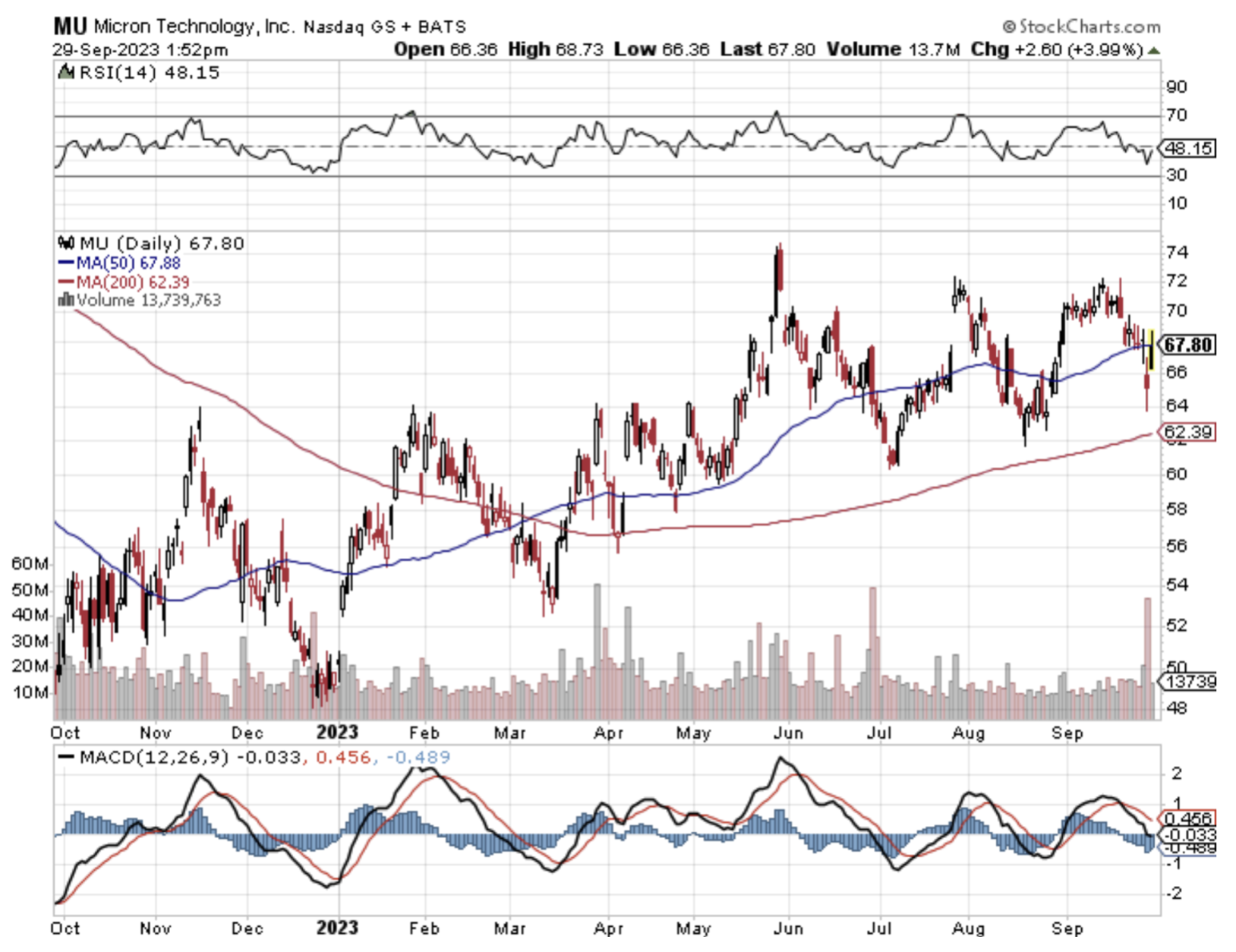

Mad Hedge Technology Letter
August 13, 2021
Fiat Lux
Featured Trade:
(ARE THE WHEELS FALLING OFF THE CHIP INDUSTRY?)
(MU), (SK HYNIX), (NVDA)

Is the chip industry about to freeze over?
Signs are creeping in of a cyclical downturn in memory chips starting in the first quarter of 2022.
This is all brought about by cycle indicators signaling that we are shifting out of 'midcycle' to 'late-cycle' for the first time since 2019 and this phase change has historically meant a challenging backdrop for forward returns.
The investments have been pouring in from chip companies to build more foundries and to improve chip performance.
Incrementally, new supply will eventually come online to address the giant chip shortage that many industries are grappling with.
However, I will say that whispers of an imminent collapse in the chip dynamics are exaggerated at best.
I don’t believe that the next cyclical downturn begins from Q1 2022 exacerbated by inventory builds.
We are still far from that happening even if the chip environment has tensed up more so now.
Micron (MU) has said that the order-filling time for chipmakers now exceeds 20 weeks.
The order-filling time represents the period from ordering a semiconductor to receiving it. That metric added on more than eight days in July, putting the total at 20.2 weeks.
Businesses from automakers to consumer-electronics companies are suffering from the chip shortage. Carmakers are expected to miss out on $100 billion in sales due to the lack of critical components.
Another industry-wide headwind is the UK's possible blocking of Nvidia’s (NVDA) planned $40 billion acquisition of Arm Holdings over national security issues.
A possible downturn in the chip cycle would also mean heavyweight South Korean memory-chip maker SK Hynix will severely underperform as well.
There are forecasts of contract prices for memory chips used in personal computers that decline by as much as 5% in the December quarter from the September quarter.
The PC market is only 20% of the DRAM market. Smartphone DRAM accounts for 40% of the market and server DRAM is 30% of the market. Miscellaneous device markets make up the remaining 10%.
Therefore, it is safe to say that not all the eggs are in one basket.
However, an analyst downgrade has set the tone for all makers of dynamic random access memory chips and puts the onus on the entrenched to prove the supposed downturn is not the case.
A world in which all relevant companies have hoarded chips because of the fear of not be able to source the right chips would be a transitory issue.
I don’t see demand falling off a cliff.
Many of these DRAM companies have moats around their business models and the case of businesses snapping up a high volume of chips and their inventories peaking out is a problem many companies would love to have.
As we progress into 2022, companies will start to plan their next iterations of devices and gadgets, and no doubt the next generation will need at least 50% more high-performing chips compared to the last version.
The pricing pressure is almost analogous to what happened with lumber prices and builders started buying at whatever prices during the short squeeze earlier this year.
This doesn’t mean the housing industry is doomed, but I understand it more as moderating prices will be a tailwind for the overall health of the industry.
Chips are famous for that boom and bust dynamic.
The price gains in chips cannot be absorbed in the same rate and as prices moderate, companies will start to look at acquiring the next batch of chips even if inventory is high.
In the short term, chip stocks are on course for a short correction that could take around a quarter to digest, but I highly doubt this will last into next year.
The 30,000-foot view shows us that many chip firms are enjoying record demand for their best chips driven by cloud customers’ capital expenditures, and even upside from the popularity of cryptocurrency-related chip products.
Demand is everywhere to be found.
The leading-edge manufacturers will take this dip in stride and adjust for the new environment in 2022.
Lower pricing expectations is something that nobody wants to hear as a chip CEO and absorbing a more challenging pricing environment into 4Q does not beat price spikes.
It gets lost that DRAM prices increased 35% over the past two quarters, with expectations for a “further modest increase” through the end of this year.
The industry can afford a little reversion to the mean pricing and shareholders will mostly stay in these stocks long term.
I understand that this dip in chip shares like Micron caused by moderation of pricing power translates into a great entry point into the stock for new buyers.
Quite quickly will investors start to shrug off this negative element to the industry and pile back into premium names or just stick with Nvidia who doesn’t sell DRAM chips.
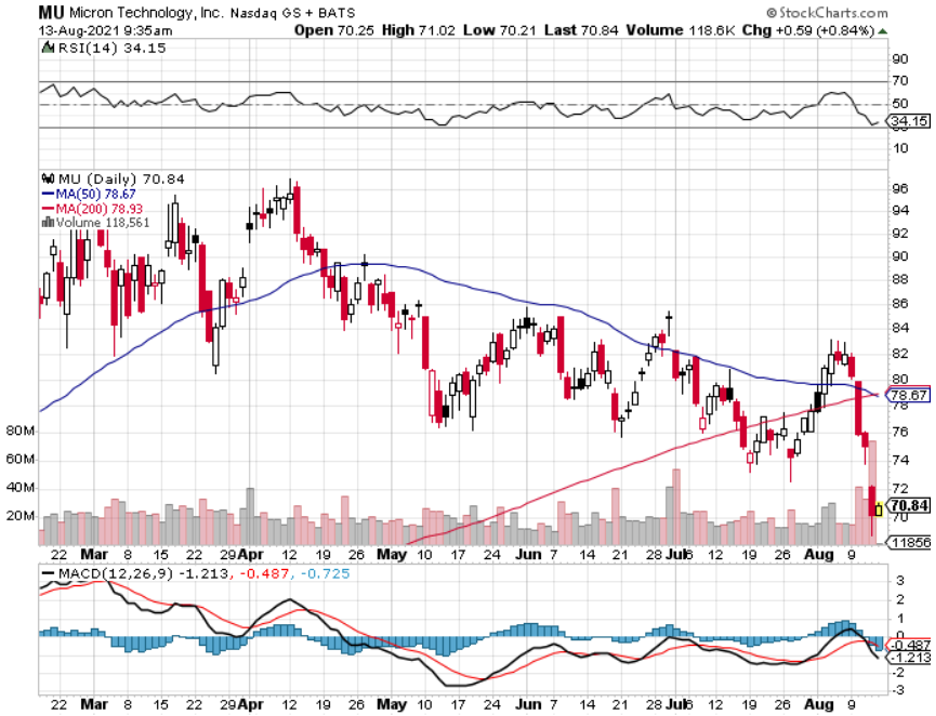
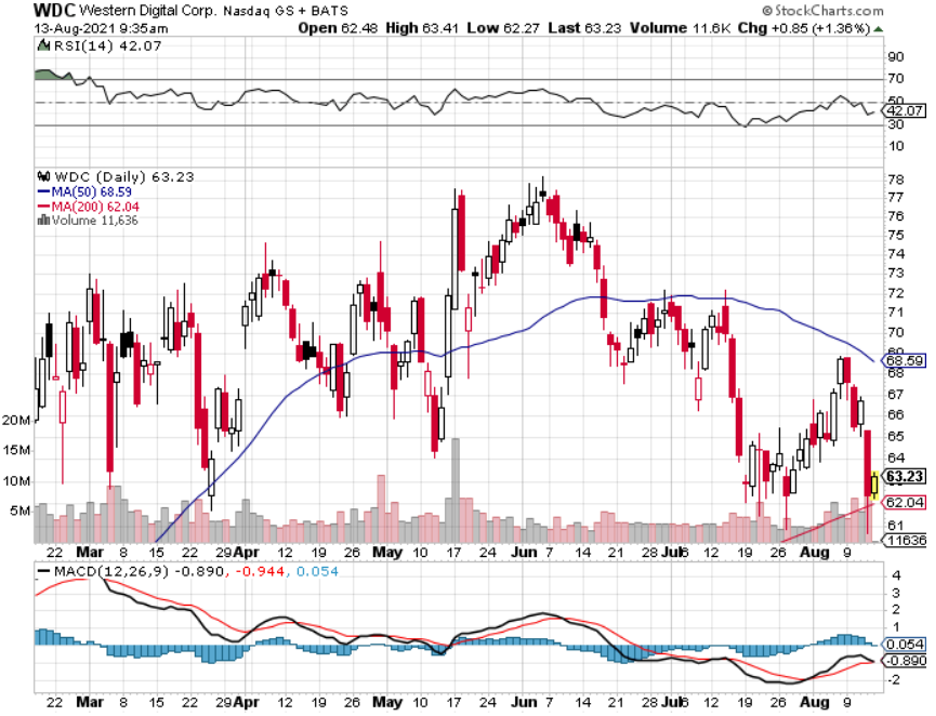
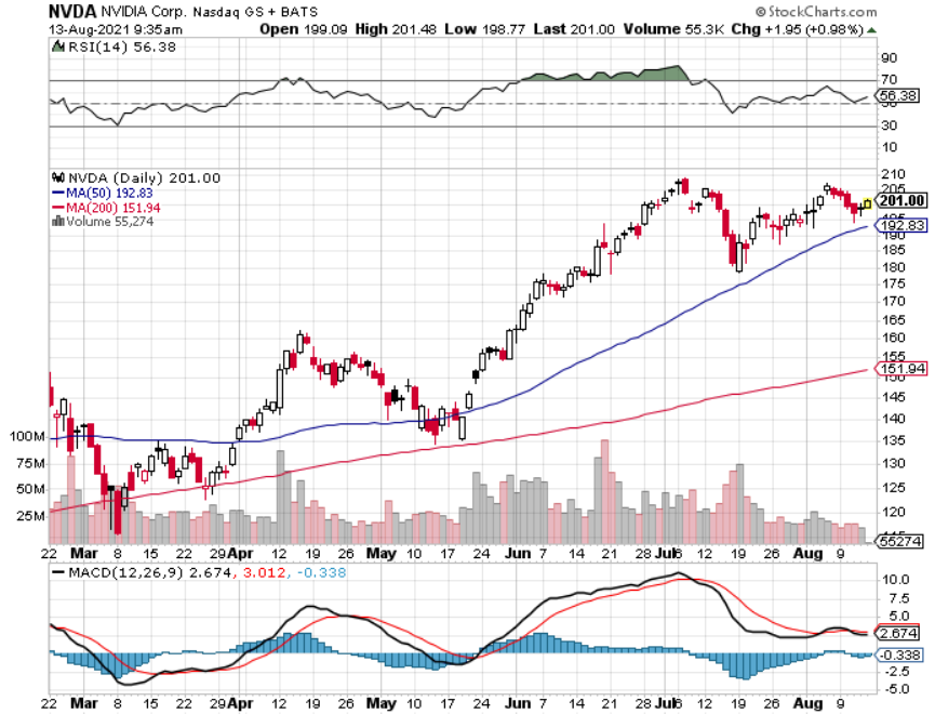
Mad Hedge Technology Letter
April 30, 2018
Fiat Lux
Featured Trade:
(RIDING THE CHIP ROLLER COASTER),
(Samsung), (SK Hynix), (AMD), (NVDA), (INTC), (MU)

The supply side of the chip market is spectacularly volatile, rotating between supply constraints and times of overcapacity.
A good place to analyze the heartbeat of the chip market is across the Pacific on South Korean shores.
South Korea takes pride and joy in having given the world two first-rate semiconductor companies - Samsung and SK Hynix.
Samsung is just behind Intel (INTC) in total annual sales.
American consumers are more familiar with Samsung through its consumer electronics division that constructs Samsung smartphones and tablets.
Samsung's silicon business mirrors the elevated earnings results stateside, as muscular demand derived from global data center expansion devours more chips than Samsung can pump out.
Global data centers in the U.S. and Asia will sustain blistering growth levels into the second quarter.
Samsung has displayed resilience to seasonally shift in the consumer electronics segment by staunchly bolstering its relentless chip business.
Samsung is harvesting the benefits of bountiful investments from over the past decade when this overly cyclical industry was exposed to extreme shifts in worldwide appetite for consumer electronics devices.
More than 70 percent of revenue was generated by the chip division boasting quarterly revenue of $19.25 billion.
In the past, memory chip companies endured a ruthless market environment with a diverse set of players ratcheting up supply on a whim then finding demand crumbling before their eyes.
Restructuring has left the burden of supplying the next generation of technology a backbreaking burden.
Tight chip supply and the general shortage of hardware rears its ugly head in earnings reports with a slew of CEOs complaining about input prices rising worse than global warming sea levels.
In Samsung's earnings call, management groaned that "memory supply and demand fundamentals remain tight."
In SK Hynix's earnings call, it echoed that "demand and supply dynamics in the market will remain favorable."
As large cap tech expands data center initiatives and throws piles of money at autonomous cars, A.I. and cloud computing, Samsung's semiconductor division appears nearly immortal.
Chip prices skyrocketed in this sellers' market and the UBS downgrade of Micron (MU) was a headscratcher.
Analyst Timothy Arcuri turned bearish on Micron citing "cyclical memory concerns" and "big estimate cuts."
Sometimes it feels that analysts don't follow the industry they cover.
It is fair to say chip volume might face marginal cuts closer to 2019, but the pendulum hasn't even started to shift back over to that direction.
Suppliers and buyers both agree that capturing the appropriate volume of chips is the first order of the day.
In response to outsized demand, Samsung will double chip capital spending because of failing to match skyrocketing demand.
Fortifying the bull case, SK Hynix guesstimated DRAM demand for the rest of 2018 to be in the "low-20 percent" and even the injection of new funds for facility expansion is not a proper solution.
Samsung also hammered into investors that it is not in the business to drive the chip prices to zero, and the gross profit metric is more important to them than most people expect.
A goldilocks scenario could ensue with Samsung supplying enough to create price hikes and ploughing its cash back into more silicon expansion.
Korean memory chip producers are expected to enjoy a booming business during the remainder of this year as global DRAM chip demand will surpass supply.
SK Hynix also indicated that server products would supersede mobile products as data center related products are all the rage.
Korea's No. 2 said NAND demand would rise by "mid-40 percent" in 2018, which is double the rise in demand than DRAM products.
Instead of the estimate cuts on which UBS is waiting, the more likely scenario is an easing of chip constraints. The easing will last just long enough before the next massive wave of demand hits with a vengeance.
You read my thoughts - the generational paradigm shift due to hyper-accelerating technology has largely made the boom-bust cycle irrelevant.
Chip demand will go up in a straight line, and this is just the beginning.
Legend has it that demand weakness shows up every 15 years. The last one was the global financial crisis in 2008, and the one before that was the dot-com crash of 2001.
In both instances, the disappearance of demand contributed to massive oversupply. The declining prices set off a price war eradicating margins and revenue.
SK Hynix net profit was $2.89 billion last quarter, an increase of 64.4 percent YOY.
SK Hynix capital allocation layout includes a spanking new factory in Cheongju, a city in South Korea.
The insatiable demand brought on by China's quest for technological supremacy is the market the new Cheongju factory will serve.
International chip directors fret that a sudden breakthrough in local Chinese technology could ignite a supply bonanza of cut-rate semiconductors, forcing a recapitulation of the entire industry that encountered egregious oversupply issues about 10 years ago.
But China can't dump low-cost chips into the market due to technological frailties.
Notice that Chinese capital has been flirting with American chip companies for years without success.
The Chinese government even initiated an investigation at the tail end of last year because DRAM price spikes were indigestible for local Chinese companies.
The dearth of supply is not just restricted to one extraneous niche of the hardware industry, as the tightness is broad-based.
Don't look further than AMD (AMD), which specializes in GPU (graphics processing unit) products and has received glowing reviews for its Ryzen and EPYC CPU processors that boast higher-level performance than previous products.
The RX Vega series is the new line of GPUs from AMD that launched last August. Tech-enthusiast website techspot.com described finding these GPUs on sale in stores as "next to impossible."
AMD is well informed of the market outlook and NVIDIA (NVDA) notes that hardware-intensive cryptocurrency mining is stoking excess marginal demand for its products.
AMD is boosting production, but manufacturing is set back by a component shortage in GDDR5 memory, which is needed in the RX 400 card.
The RX 500 card, part of the RX Vega line, is also having delays with a lack of HBM2 memory.
Crypto-fanatics aren't the only consumers clamoring for extra GPUs; gamers require GPUs to perform at top levels.
AMD has even urged retailers to advise gamers of any outlets where they can buy GPUs because of the dearth of supply.
Gamers are being outmaneuvered for GPUs as crypto-miners usually buy up every last unit to transport to mining farms in far-flung places with cheap energy.
Hardware products cannot be produced fast enough to meet demand.
Other industries vying for a portion of chips are military, aerospace, IoT (Internet of Things) products, and autonomous cars.
Incremental supply is accruing but often the supply is added slower than initially thought. Suppliers are hesitant to double down on new factories because of past, bitter experiences at the end of a cycle.
Management monitors inventory channels like a hawk eyeing its prey, and it's clear that organic demand is following through.
After running away with 22.2% growth in 2017, the semiconductor industry is due to take a quick breather expanding in the upper teens in 2018.
A year is an eternity in technology and calling for production "cuts" in a period of massive undersupply is premature.
The claim of "cyclical" headwinds comes at a time of a new-found immunity to cyclical demand and is dubious at best.
This secular story has legs. Don't believe every analyst that pushes out reports. They often have alternative motives.
Nvidia (NVDA) reports earnings on May 10, and CEO Jensen Huang does a great job explaining the development at the front-end of the tech revolution.
Earnings should be extraordinary. Imagine if the price of bitcoin stabilizes, GPU manufacturers will wrestle with continuous quarters of strained supply.
I am bullish on chips.
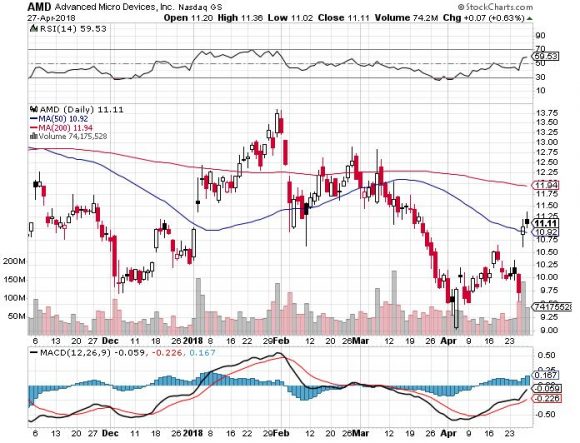
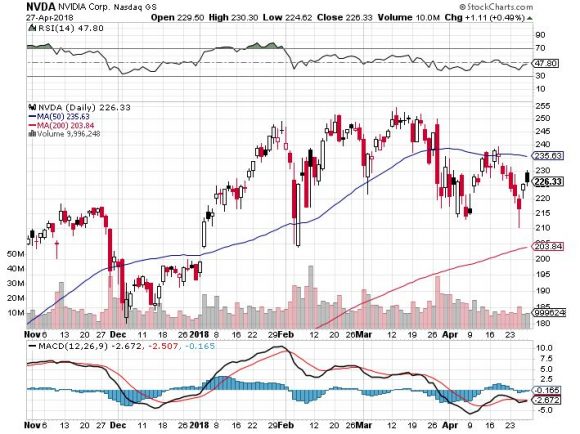
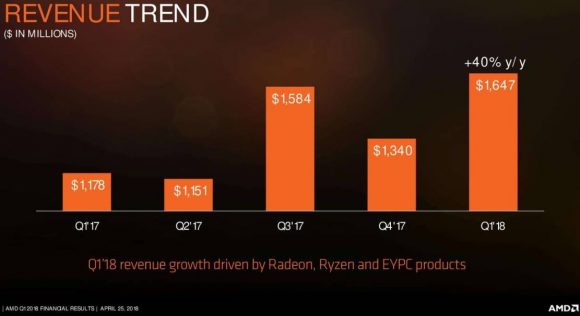
_________________________________________________________________________________________________
Quote of the Day
"Focus on the 20 percent that makes 80 percent of the difference." - said Salesforce CEO Marc Benioff when asked to explain the story of his cloud business.

Legal Disclaimer
There is a very high degree of risk involved in trading. Past results are not indicative of future returns. MadHedgeFundTrader.com and all individuals affiliated with this site assume no responsibilities for your trading and investment results. The indicators, strategies, columns, articles and all other features are for educational purposes only and should not be construed as investment advice. Information for futures trading observations are obtained from sources believed to be reliable, but we do not warrant its completeness or accuracy, or warrant any results from the use of the information. Your use of the trading observations is entirely at your own risk and it is your sole responsibility to evaluate the accuracy, completeness and usefulness of the information. You must assess the risk of any trade with your broker and make your own independent decisions regarding any securities mentioned herein. Affiliates of MadHedgeFundTrader.com may have a position or effect transactions in the securities described herein (or options thereon) and/or otherwise employ trading strategies that may be consistent or inconsistent with the provided strategies.
This site uses cookies. By continuing to browse the site, you are agreeing to our use of cookies.
OKLearn moreWe may request cookies to be set on your device. We use cookies to let us know when you visit our websites, how you interact with us, to enrich your user experience, and to customize your relationship with our website.
Click on the different category headings to find out more. You can also change some of your preferences. Note that blocking some types of cookies may impact your experience on our websites and the services we are able to offer.
These cookies are strictly necessary to provide you with services available through our website and to use some of its features.
Because these cookies are strictly necessary to deliver the website, refuseing them will have impact how our site functions. You always can block or delete cookies by changing your browser settings and force blocking all cookies on this website. But this will always prompt you to accept/refuse cookies when revisiting our site.
We fully respect if you want to refuse cookies but to avoid asking you again and again kindly allow us to store a cookie for that. You are free to opt out any time or opt in for other cookies to get a better experience. If you refuse cookies we will remove all set cookies in our domain.
We provide you with a list of stored cookies on your computer in our domain so you can check what we stored. Due to security reasons we are not able to show or modify cookies from other domains. You can check these in your browser security settings.
These cookies collect information that is used either in aggregate form to help us understand how our website is being used or how effective our marketing campaigns are, or to help us customize our website and application for you in order to enhance your experience.
If you do not want that we track your visist to our site you can disable tracking in your browser here:
We also use different external services like Google Webfonts, Google Maps, and external Video providers. Since these providers may collect personal data like your IP address we allow you to block them here. Please be aware that this might heavily reduce the functionality and appearance of our site. Changes will take effect once you reload the page.
Google Webfont Settings:
Google Map Settings:
Vimeo and Youtube video embeds:
